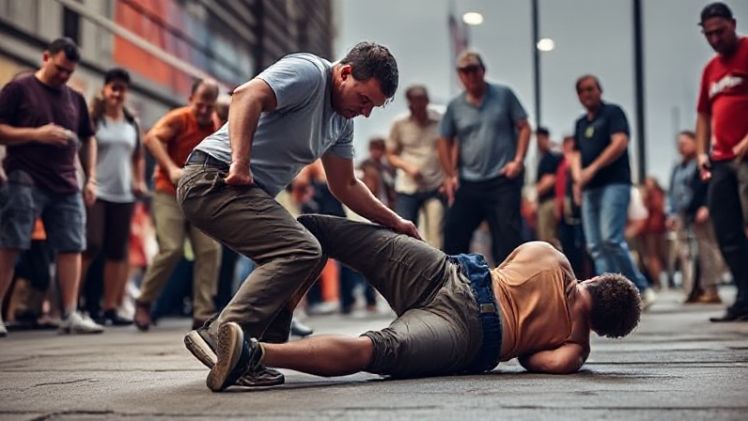A curb stomp is one of the most brutal and devastating acts of violence. It has been depicted in movies, TV shows, and even video games, but the real-life consequences are far graver than what is shown on screen. Victims of a curb stomp often face life-threatening injuries, while perpetrators face serious legal repercussions. In this article, we will explore the physical, psychological, and legal aftermath of a curb stomp, shedding light on the severity of this violent act.
The Origins and Infamy of the Curb Stomp
The curb stomp became infamous due to its depiction in pop culture, most notably in the movie American History X. However, its roots lie in real-world violence, often associated with gang activity and hate crimes. Understanding the history of this act helps us grasp why it carries such brutal consequences.
Immediate Physical Aftermath: What Happens to the Victim?
A curb stomp inflicts catastrophic injuries due to the sheer force applied to the skull or jaw. Some of the immediate effects include:
- Fractured Skull and Jaw – The impact often results in severe fractures, requiring extensive reconstructive surgery.
- Brain Damage – A direct hit can lead to concussions, traumatic brain injuries (TBIs), or even permanent cognitive impairment.
- Broken Teeth and Facial Disfigurement – Victims usually suffer broken or knocked-out teeth, severe lacerations, and crushed facial bones.
- Internal Bleeding and Organ Damage – The force may also impact internal organs, leading to life-threatening conditions.
Long-Term Physical Consequences
Even if a victim survives, the long-term consequences can be life-altering. These include:
- Chronic Pain – Many survivors deal with lifelong pain due to nerve and bone damage.
- Disfigurement – Reconstructive surgeries may not fully restore facial structure.
- Cognitive Impairment – Severe brain damage can result in memory loss, speech difficulties, or impaired motor functions.
- Speech and Eating Difficulties – Damage to the jaw or throat may permanently alter speech and the ability to chew food properly.
Psychological Aftermath: Trauma Beyond the Physical Wounds
Beyond physical injuries, victims often suffer deep psychological trauma. Common psychological effects include:
- Post-Traumatic Stress Disorder (PTSD) – Flashbacks, nightmares, and anxiety are common in survivors.
- Depression and Anxiety – The emotional toll of the attack can lead to long-term mental health struggles.
- Social Withdrawal – Many victims isolate themselves due to fear or embarrassment from disfigurement.
- Trust Issues – Survivors may find it difficult to trust others, especially if the attack was unexpected.
Legal Consequences for Perpetrators
Committing a curb stomp is considered a violent crime in most legal systems. The severity of punishment depends on the intent and the outcome of the attack. Possible legal consequences include:
- Aggravated Assault Charges – If the victim survives but suffers serious injuries, the attacker may face decades in prison.
- Attempted Murder – A curb stomp can be charged as attempted murder if it is determined that there was intent to kill.
- Murder Charges – If the victim dies, the perpetrator will likely be charged with murder, carrying a life sentence or the death penalty in some jurisdictions.
- Hate Crime Enhancements – If the attack is racially or ethnically motivated, additional charges may apply.
Real-Life Cases of Curb Stomp Violence
Several real-life cases demonstrate the extreme consequences of curb stomping. For example:
- The Case of Bryan Stevenson – A 2018 case where the perpetrator received a life sentence after curb-stomping a man into a coma.
- Gang-Related Incidents – Many documented curb stomps occur in gang fights, leading to severe retaliatory violence.
- Hate Crime Attacks – Some curb stomps have been carried out as hate crimes, resulting in harsh federal penalties.
These cases highlight the real dangers and irreversible damage caused by such violent acts.
Medical Treatment and Recovery Process
Surviving a curb stomp requires extensive medical intervention. The treatment process may include:
- Emergency Surgery – To repair skull fractures, reconstruct the jaw, and stop internal bleeding.
- Dental Reconstruction – Implants, prosthetics, or reconstructive surgery for lost teeth.
- Neurological Rehabilitation – Therapy to regain motor skills, speech, and cognitive function.
- Psychological Therapy – Counseling and PTSD treatment to help victims recover mentally.
Preventing Violent Incidents: How to Stay Safe
Preventing curb stomp incidents involves community awareness and personal safety measures:
- Avoid Confrontations in High-Risk Areas – Stay away from known violent hotspots.
- De-escalation Techniques – Knowing how to calm a hostile situation can save lives.
- Self-Defense Awareness – Understanding personal safety strategies and self-defense tactics can be beneficial.
- Community Support Programs – Anti-violence initiatives can help deter gang-related violence.
Conclusion:
The aftermath of a curb stomp is both physically and emotionally devastating. Victims endure severe, often irreversible injuries, while perpetrators face harsh legal consequences. Society must recognize the brutality of this act and work towards preventing such violence through education, intervention, and strict legal enforcement. Understanding the realities of a curb stomp aftermath can help raise awareness and promote a safer community for everyone.
Frequently Asked Questions (FAQ)
1. What is a curb stomp?
A curb stomp is an extremely violent attack where a victim’s head is placed on a curb and then stomped, causing severe injuries or death.
2. Can someone survive a curb stomp?
Survival is possible but rare. Even if a victim lives, they often suffer permanent brain damage, facial disfigurement, or paralysis.
3. What are the legal consequences of a curb stomp?
Legal consequences range from aggravated assault to murder, with sentences varying from years in prison to life or the death penalty in severe cases.
4. How is a curb stomp depicted in pop culture?
Movies like American History X and video games like Gears of War have popularized the curb stomp, often failing to show its real-life brutality.
5. How can curb stomp violence be prevented?
Preventing such violence requires education, community programs, law enforcement interventions, and promoting non-violent conflict resolution methods.

